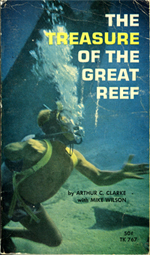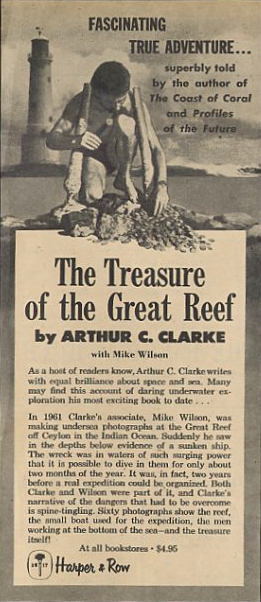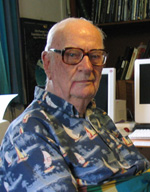Questar Distribution
![]() News
News ![]() Notes & Interesting Articles
Notes & Interesting Articles ![]() Overview
Overview ![]() Pricing
Pricing ![]() Products
Products ![]() Service or Repair
Service or Repair
Questar Telescopes ![]() LD Surveillance Systems
LD Surveillance Systems ![]() LD Microscopes
LD Microscopes ![]() Accessories
Accessories


Arthur C. Clarke's Comments About His Questar 3-1/2 Telescope
Excerpts from the nonfiction book "The Treasure of the Great Barrier Reef" by Arthur C. Clarke (b. 1917, d. 2008), from Company Seven's archives.-
From Chapter 13: "False Start"
"We waited, scanning the horizon for the first sight of the returning boat. I had brought with me, for just such a purpose, the finest small telescope ever built--the 3-1/2 inch Questar, a jewel of precision optics which has produced close-ups of the moon that could easily be mistaken for Mount Wilson photographs. Although the barrel is only eight inches long, a combination of lens and mirror makes the light traverse the tube three times, with the result that the instrument is equivalent to one yard in length. Various eyepieces give magnifications of up to 180, though it is easy to go higher than this on those rare occasions when the clarity of the atmosphere permits. There is an electric drive in the base that will keep the field of view centered on a star all night--no, I am not getting a penny from the Questar Corporation, but perhaps I had better stop here.
Click on image to see enlarged view (222,568 bytes).
In the middle of the morning, as I scanned the horizon, I caught my first glimpse of Ran Muthu's canvas hood, bobbing intermittently above the edge of the earth. As she crawled over the skyline, she looked like a jeep just awash; it was more than an hour before she reached us and dropped anchor outside the resthouse. The telescope has saved us a great deal of anxiety and worry, and it was to save me a good deal more in the weeks to come."
Note the Great Basses Reef Lighthouse in the background (147,557 bytes).
-
From Chapter 21: "Piranhas and Elephants"
"While I was awaiting for the boat to return, I persuaded some of the local youngsters to record their village songs, and the playbacks caused endless amusement for them. Having established a fund of good will with the tape recorder, I had no difficulty in getting the volunteers to carry telescope, tripod, and cameras up tot he top of the hill overlooking Kirinda. They were fascinated to see the lighthouse and passing ships brought from ten miles to within a few hundred yards, but I was much more interested in the Ran Muthu, as she bobbed up and down on he far side of the reef.
Visibility was remarkably good, despite the ten miles of hot, trembling air that lay between my hilltop and the Great Basses. So I couple the Nikon to the Questar, hels a large red filter from an aerial surveying camera over the objective, and shot off a roll of film. While I developed it back in Colombo, I was quite pleased with the result; Ran Muthu's canvas awning was clearly visible, peeing above the breakers foaming over the reef, with the white tower of the lighthouse looming in the background.
I watched from the hill for over an hour, swinging the telescope around the sky from time to time to look at the ships that were streaming past this busy crossroads in the sea."
- "The Treasure of the Great Reef" was originally published in New York by Harper & Row, 1964. This is Volume 3 of the Blue Planet Trilogy.
- The author refers to what was then known as Ceylon, now Sri Lanka. Krinda is a community located on the southeast coast of Sri Lanka at Latitude 6.22, Longitude 81.33. This was among the areas that bore the brunt of the destruction brought forth by the Earthquake and Tsunami on 26 December 2004. The earthquake originated in the Indian Ocean just north of Simeulue island, off the western coast of northern Sumatra, Indonesia. Then the resulting Tsunami devastated the shores of Indonesia, Sri Lanka, South India, Thailand and other countries with waves up to 30 m (100 feet) high.
- The 125 foot tall lighthouse (seen in the image above right) remains on the Great Basses Reef about ten miles south-south east of Kirinda. The lighthouse survived the Tsunami although the lighting system sustained damage.
Sir Arthur C. Clarke died in Colombo, Sri Lanka on 19 March 2008 a few days after he reviewed the final manuscript of his latest science fiction novel, The Last Theorem co-written with the American author Frederik Pohl. He asked to be buried at the Kanatte General Cemetery in Colombo in a burial plot owned by the family of Hector Ekanayake, his business partner.
Right: Sir Arthur C. Clarke at his home in Sri Lanka on 28 March 2005. Image taken by Amy Marash, used by his permission.
Click on the image to see an enlarged view.
Contents Copyright 1964-2008 Arthur C. Clarke, Amy Marash, Company Seven and Questar Corp. All Rights Reserved




